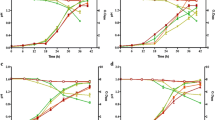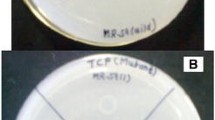Abstract
The aim of this study was to analyze if cofactor pyrroquinoline quinone from Serratia sp. S119 is involved in the inorganic phosphate solubilization mechanism and in its ability to promote the plant growth. Site directed mutagenesis was performed to obtain a pqqE- minus mutant of strain Serratia sp. S119. The phosphate solubilization ability, gluconate and PQQ production of the mutant Serratia sp. RSL (pqqE-) was analyzed. Mutant RSL (pqqE-) showed significant decrease in P soluble and gluconic acid levels produced and undetectable levels of PQQ cofactor compared with wild-type strain. Complementation with synthetic PQQ cofactor restored P solubilization and gluconate production reaching the levels produced by wild-type strain. PqqE gene sequence indicated that it is highly conserved within Serratia strains and its product shows conserved motifs found in other PqqE proteins of several bacteria. The effect of the inoculation of the PQQ- mutant on peanut and maize plants was evaluated in pot assays. Plants growth parameters showed no differences among the different treatments indicating that PQQ from Serratia sp. S119 is not involved in the growth promotion of these plants. PQQ cofactor is essential for phosphate solubilization ability of Serratia sp. S119 but is not required for growth promotion of peanut and maize plants.






Similar content being viewed by others
References
Alexeyev MF (1999) The pKNOCK series of broad-host-range mobilizable suicide vectors for gene knockout and targeted DNA insertion into the chromosome of Gram-negative bacteria. BioTechniques 26:824–828
Anthony C (2004) The quinoprotein dehydrogenases for methanol and glucose. Arch Biochem Biophys 428:2–9
Anzuay MS, Frola O, Angelini JG, Ludueña LM, Fabra A, Taurian T (2013) Genetic diversity of phosphate-solubilizing peanut (Arachis hypogaea L.) associated bacteria and mechanisms involved in this ability. Symbiosis 60:143–154
Arcand M, Schneider KD (2006) Plant and microbial based mechanisms to improve the agronomic efectiveness of phosphate rock: a review. An Acad Bras Cienc 78:791–807
Ausubel FM, Blent R, Kingston RE (1991) In: current protocols in molecular biology. Wiley, New York
Biville F, Turlin E, Gasser F (1989) Cloning and genetic analysis of six pyrroloquinoline quinone biosynthesis genes in Methylobacterium organophilum DSM760. J Gen Microbiol 135:2917–2929
Chen YP, Rekha PD, Arun AB, Shen FT, Lai WA, Young CC (2006) Phosphate solubilizing bacteria from subtropical soil and their tri- calcium phosphate solubilizing abilities. Appl Soil Ecol 34:33–41
Choi O, Kim J, Kim JG, Jeong Y, Moon JS, Park CS, Hwang I (2008) Pyrroloquinoline quinone is a plant growth promotion factor produced by Pseudomonas fluorescens B16. Plant Physiol 146:657–668
de Bruijn F (1992) Use of repetitive (repetitive extragenic palin- dromic and enterobacterial repetitive intergeneric consensus) sequences and the polymerase chain reaction to fingerprint the genomes of Rhizobium meliloti isolates and other soil bacteria. Appl Environ Microbiol 58:2180–2187
Fender JE, Bender CM, Stella NA, Lahr RM, Kalivoda EJ, Shanks RM (2012) Serratia marcescens quinoprotein glucose dehydrogenase activity mediates medium acidification and inhibition of prodigiosin production by glucose. Appl Environ Microbiol 78(17):6225–6235
Fiske EH, Subbarow Y (1925) The solubilization of phosphate: the action of various organic compounds on dicalcium and tricalcium phosphate. N Z J Sci Technol 33:436–444
Gliese N, Khodaverdi V, Görisch H (2010) The PQQ biosynthetic operons and their transcriptional regulation in Pseudomonas aeruginosa. Arch Microbiol 192(1):1–14
Goldstein AH (1995) Recent progress in understanding the molecular genetics and biochemistry of calcium phosphate solubilisation by gram negative bacteria. Biol Agric Hortic 12:185–193
Goosen N, Horsman HP, Huinen RG, van de Putte P (1989) Acinetobacter calcoaceticus genes involved in biosynthesis of the coenzyme pyrroloquinoline quinone nucleotide sequence and expression in Escherichia coli K-12. J Bacteriol 171:447–455
Guo YB, Li J, Li L, Chen F, Wu W, Wang J, Wang H (2009) Mutations that disrupt either the pqq or the gdh gene of Rahnella aquatilis abolish the production of an antibacterial substance and result in reduced biological control of grapevine crown gall. Appl Environ Microbiol 75(21):6792–6803
Gyaneshwar P, Kumar N, Parekh LJ, Poole PS (2002) Role of soil microorganisms in improving P nutrition of plants. Plant Soil 245:83–93
Haft DH, Basu MK (2011) Biological systems discovery in silico: radical S-adenosylmethionine protein families and their target peptides for posttranslational modification. J Bacteriol 193(11):2745–2755
Hall T (1999) BioEdit: a user-friendly biological sequence alignment editor and analysis program for Windows 95/ 98/NT. Nucl Acids Symp Ser 41:95–98
Han SH, Kim CH, Lee JH, Park JY, Cho SM, Park SK, Kim KY, Krishnan HB, Kim YC (2008) Inactivation of pqq genes of Enterobacter intermedium 60-2G reduces antifungal activity and induction of systemic resistance. FEMS Microbiol Lett 282:140–146
Hoagland D, Arnon D (1950) Water culture method for growing plants without soil. California Agric Exp Station Circ 347
Hoben HJ, Somasegaran P (1982) Comparison of the pour, spread, and drop plate methods for enumeration of Rhizobium spp. in inoculants made from presterilized peat. Appl Environ Microbiol 44:1246–1247
Huff JP, Grant BJ, Penning CA, Sullivan KF (1990) Optimization of routine transformation of Escherichia coli with plasmid DNA. BioTechniques 9:570–577
Kaur G, Sudhakara RM (2014) Role of phosphate-solubilizing bacteria in improving the soil fertility and crop productivity in organic farming. Arch Agron Soil Sci 60:549–564
Kim KY, Mcdonald GA, Jordan D (1997) Solubilization of hydroxypatite by Enterobacter agglomerans and cloned Escherichia coli in culture medium. Biol Fertil Soils 24:347–352
Kim CH, Han SH, Kim KY, Cho BH, Kim YH, Koo BS, Kim YC (2003) Cloning and expression of pyrroloquinoline quinone (PQQ) genes from a phosphate-solubilizing bacterium Enterobacter intermedium. Curr Microbiol 47:457–461
Ko KS, Lee HK, Park MY, Lee KH, Yun YJ, Woo SY (2002) Application of RNA polymerase ß-subunit gene (rpoB) sequences for the molecular differentiation of Legionellaspecies. J Clin Microbiol 40:2653–8
Kuklinsky-Sobral J, Araújo W, Mendes R, Geraldi I, Pizzirani- Kleiner A, Azevedo J (2004) Isolation and characterization of soybean associated bacteria and their potential for plant growth promotion. Environ Microbiol 6:1244–1251
Kumar V, Behl RK, Narula N (2001) Establishment of phosphate-solubilizing strains of Azotobacter chroococcum in the rhizosphere and their effect on wheat cultivars under greenhouse conditions. Microbiol Res 156:87–93
Laguerre G, Allard MR, Revoy F, Amarger N (1994) Rapid identification of rhizobia by restriction fragment length polymorphism analysis of PCR-amplified 16 s rRNA genes. Appl Environ Microbiol 60:56–63
Latham JA, Iavarone AT, Barr I, Juthani PV, Klinman JP (2015) PqqD is a novel peptide chaperone that forms a ternary complex with the radical S-adenosylmethionine protein PqqE in the pyrroloquinoline quinone biosynthetic pathway. J Biol Chem 290(20):12908–12918
Mehta S, Nautiyal CS (2001) An efficient method for qualitative screening of phosphate-solubilizing bacteria. Curr Microbiol 43:51–56
Meulenberg JJM, Sellink E, Riegman NH, Postma W (1992) Nucleotide sequence and structure of the Klebsiella neumoniae pqq operon. Mol Gen Genet 232:284–294
Morris CJ, Biville F, Turlin E, Lee E, Ellermann K, Fan WH, Ramamoorthi R, Springer AL, Lindstrom ME (1994) Isolation, phenotypic characterization and complementation analysis of mutants in Methylobacterium extorquens AM1 unable to synthesize pyrroloquinoline quinone and sequence of pqqD, pqqG, and pqqC. J Bacteriol l76:1746–1755
Murphy J, Riley JP (1962) A modified single solution method for the determination of phosphore in natural waters. Anal Chim Acta 27:31–36
Nahas E (1996) Factors determining rock phosphate solubilization by microorganisms isolated from soil. World J Microbiol Biotechnol 12:567–572
Nei M, Kumar S (2000) Molecular evolution and phylogenetics. Oxford university press
Ogut M, Er F, Kandemir N (2010) Phosphate solubilization potentials of soil Acinetobacter strains. Biol Fertil Soils 46:707–715
Pereira P, Ibáñez F, Rosenblueth M, Etcheverry M, Martínez-Romero E (2011) Analysis of the bacterial diversity associated with the roots of maize (Zea mays L.) through culture-dependent and culture-independent methods. ISRN Ecol. doi:10.5402/2011/938546
Pérez E, Sulbarán M, Ball MM, Yarzabál LA (2007) Isolation and characterization of mineral phosphate-solubilizing bacteria naturally colonizing a limonitic crust in the southeastern Venezuelan region. Soil Biol Biochem 39:2905–2914
Puehringer S, Metlitzky M, Schwarzenbacher R (2008) The pyrroloquinoline quinone biosynthesis pathway revisited: a structural approach. BMC Biochem 9(1):8
Richardson AE, Hadobas PA, Hayes JE, O’Hara CP, Simpson RJ (2001) Utilization of phosphorus by pasture plants supplied with myoinositol hexaphosphate is enhanced by the presence of soil microorganisms. Plant Soil 229:47–56
Rodriguez H, Fraga R, Gonzalez T, Bashan Y (2006) Genetics of phosphate solubilization and its potential applications for improving plant growth-promoting bacteria. Plant Soil 287:15–21
Rossolini GM, Schippa S, Riccio ML, Berlutti F, Macaskie LE, Thaller MC (1998) Bacterial nonspecific acid phosphohydrolases: physiology, evolution and use as tools in microbial biotechnology. Cell Mol Life Sci 54:833–850
Sambrook JE, Fritsh EF, Maniatis T (1989) Molecular cloning: a laboratory manual. Cold Spring Harbor Laboratory, Cold Spring Harbor
Shen YQ, Bonnot F, Imsand EM, Rose JM, Sjölander K, Klinman JP (2012) Distribution and properties of the genes encoding the biosynthesis of the bacterial cofactor, pyrroloquinoline quinone. Biochemistry 51(11):2265–2275
Simon R, Priefer U, Piihler A (1982) A broad host range mobilization system for in vivo genetic engineering: transposon mutagenesis in gram-negative bacteria. Biotechnology 1:784–791
Simon R, Priefer U, Pushler A (1983) A broad-host-range mobilization system for in vivo genetic engineering: transposon mutagenesis in Gram-negative bacteria. BioTechnology 1:784–791
Somasegaran P, Hoben HJ (1994) Handbook for rhizobia: methods in legume– rhizobium technology. Section1, pp 3–6.
Son HJ, Park GT, Cha MS, Heo MS (2006) Solubilization of insoluble inorganic phosphates by a novel salt and pH-tolerant Pantoea agglomerans R-42 isolated from soybean rhizosphere. Bioresour Technol 97:204–210
Springer AL, Ramamoorthi R, Lidstrom ME (1996) Characterization and nucleotide sequence of pqqE and pqqF in Methylobacterium extorquens AM1. J Bacteriol 178(7):2154–2157
Stites TE, Mitchell AE, Rucker RB (2000) Physiological importance of quinoenzymes and the O-quinone family of cofactors. J Nutr 130:719–727
Tamura K, Dudley J, Nei M, Kumar S (2007) MEGA4: molecular evolutionary genetics analysis (MEGA) software version 4.0. Mol Biol Evol 24:1596–1599
Taurian T, Aguilar OM, Fabra A (2002) Characterization of nodulating peanut rhizobia isolated from a native soil population in Córdoba, Argentina. Symbiosis 33:59–72
Taurian T, Anzuay MS, Angelini JG, Tonelli MA, Ludueña L, Pena D, Ibañez F, Fabra A (2010) Phosphate-solubilizing peanut associated bacteria: screening for plant growth-promoting activities. Plant Soil 329:421–431
Velterop JS, Sellink E, Meulenberg JJ, David S, Bulder I, Postma PW (1995) Synthesis of pyrroloquinoline quinone in vivo and in vitro and detection of an intermediate in the biosynthetic pathway. J Bacteriol 177(17):5088–5098
Walpola B, Yoon M (2013) Isolation and characterization of phosphate solubilizing bacteria and their co-inoculation efficiency on tomato plant growth and phosphorous uptake. Afr J Microbiol Res 7:266–275
Wang SC, Perry A (2007) S-adenosylmethionine as an oxidant: the radical SAM superfamily. TRENDS in Biochem Sci 32 No.3
Wecksler SR, Stoll S, Tran H, Magnusson OT, Wu SP, King D, Britt RD, Klinman JP (2009) Pyrroloquinoline quinone biogenesis: demonstration that PqqE from Klebsiella pneumoniae is a radical S-adenosyl-Lmethionine enzyme. Biochemistry 48:10151–10161
Whiting PH, Midgley M, Dawes EA (1976) The regulation of transport of glucose, gluconate and 2-oxogluconate and of glucose catabolism in Pseudomonas aeruginosa. Biochemistry 154:659–668
Acknowledgments
This research was supported by Consejo Nacional de Investigaciones Científicas y Técnicas (CONICET), Secretaría de Ciencia y Técnica de la Universidad Nacional de Río Cuarto (SECYT-UNRC), CONICET, Agencia Nacional de Promoción Científica y Tecnológica (ANPCyT) and Fundación Maní Argentino. L.M.L., M.S.A. and M.P.M. are fellowships from CONICET, T.T., J.G.A., G.B., M.F.L. and A.F. are members of research career of CONICET, Argentina. The authors are grateful to Eugenia Castelli (PhD) and Eleonora García Véscovi (PhD) for site directed mutagenesis assistance.
Author information
Authors and Affiliations
Corresponding author
Rights and permissions
About this article
Cite this article
Ludueña, L.M., Anzuay, M.S., Angelini, J.G. et al. Role of bacterial pyrroloquinoline quinone in phosphate solubilizing ability and in plant growth promotion on strain Serratia sp. S119. Symbiosis 72, 31–43 (2017). https://doi.org/10.1007/s13199-016-0434-7
Received:
Accepted:
Published:
Issue Date:
DOI: https://doi.org/10.1007/s13199-016-0434-7




